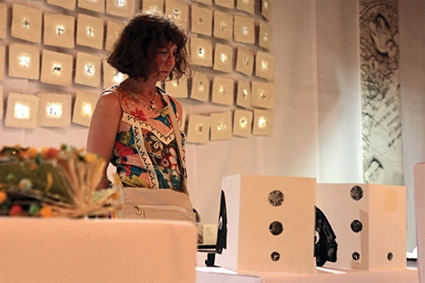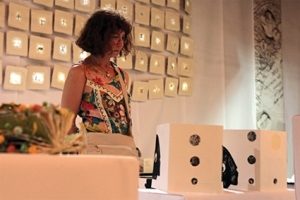Bulgarian and Japanese Embassies Sponsor Exhibition of International Paper Art
PAPER INNOVATION, a paper-based art exhibition featuring the works of artists from around the world, opened last Friday night at the Ioseb Grishasvhili Tbilisi History Museum.
The exhibition, co-presented by the Bulgarian and Japanese embassies, is based around the collection of the AMATERAS foundation, a seven year-old Bulgarian project devoted to paper art centered around the husband-wife team of Todor and Daniela Todorova. The work of the two as a couple poses a striking contrast, since Mr. Todorov is in fact a sculptor who by his own admission feels much more at home with more solid materials. Panels against the back wall, displaying images of and information about his in-situ work, ground the exhibition as a whole, imbuing a sense of balance between the fragile, airy, placeless and timeless work so characteristic of the paper medium and the heavy, grounded world of Mr. Todorov’s sculpture.
Of course, paper art is also inherently sculptural, and the exhibition makes playful, productive use of its space to showcase this. Forests of long, painted and carefully cut-apart scrolls descend from one end of the ceiling while thickly painted strips of paper, hardly recognizable as paper, imitate waterfalls at the other. A large circular “garden” serves as the centerpiece.
What’s more, visitors enjoying the Bulgarian wine and Japanese sake on offer Friday evening were able to watch calligraphic artist Kihachiro Nishiura create works in real time before them, dressed in a kimono and working with thick black strokes to write “Gamarjoba to the Moon” on a huge white sheet in the middle of the floor.
Daniela Todorova, the driving force behind the exhibition, is a Bulgarian artist who has been working primarily with paper since 2006. She and her husband have used the AMATERAS umbrella to create a host of international projects and exhibitions, including what has become the Sofia Paper Art Fest. This current exhibition, she explained, stemmed mainly from the relationships that those years of collaboration have cultivated – specifically with Plamen Bonchev, the current Bulgarian Ambassador to Georgia.
“The idea of this project is to be mainly international, and to show that nowadays people are more connected than in the past,” Ms. Todorova explained. But this is far from the end of AMATERAS’ ambitions in Georgia. Having conducted successful two-country art collaborations in the past, the Todorovs are now looking to return, even as early as June, to create a collaboration specifically between Bulgaria and Georgia. To hear her discuss it, such a project is so natural a fit that it’s almost surprising it hasn’t happened before.
“The Georgians are very sensitive,” she says. “They are very sensitive about their culture, about their identity, about their past, and this is usual for all countries which have at one time or another been under some other that tried to change history, tried to change how they identified themselves. We are also from a post-communist country. We have this syndrome… countries with ancient land, with ancient civilizations. We have a lot of connections.”
And what about the medium? The practice of paper art, after all, isn’t a remotely Bulgarian tradition, but is borrowed explicitly from the Far East. Even the name AMATERAS, as the Japanese Ambassador informed us, is from Japanese, meaning “the Sun Shines in the Sky.” So what attracts Ms. Todorova, and the cadre of artists from around the world, everywhere from the United States to Finland and full circle back to modern Japan, to this kind of work?
“Design, and a pure line,” Ms. Todorova says, “and the silence in the art. Silence, especially in contemporary art, has to exist. Because we are too busy in our minds, with too many things. Therefore when we look at art we have to fill a free space, and then our imagination will be developed, and we will be able to see something that is shared with ourselves, which can be absolutely personal.”
The exhibition will be shown at the Ioseb Grishasvhili Tbilisi History Museum until December 4th.
Robert Isaf











